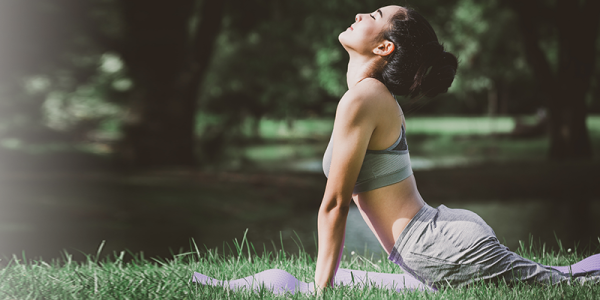
Nightmare commutes. Crazy deadlines. Your weekly grocery bill. Car trouble. Screaming kids. Divisive politics. Impossible schedules. Yes, stress is a fact of modern life. We buck up and do what we have to do but the stress never seems to stop.
Stress can bring on all kinds of unpleasant physical and emotional symptoms from muscle tension and panic attacks to hives, headaches, and heartburn. What’s worse, lasting stress has been linked to a wide range of dangerous changes in your body, such as:
- Increased glucose production
- Decreased insulin production
- Inflammation of the arterial walls
- Greater percentage of body fat
- Elevated blood pressure
All these changes are risk factors for metabolic syndrome, pre-diabetes and diabetes, atherosclerosis, heart disease, and stroke.
We all have our own ways of taking breaks from stress. Soaking in a hot bath, watching a funny movie, or sipping some soothing herb tea can temporarily take us away from our worries. But adopting a regular mind/body relaxation practice provides a stress-relieving routine you can enjoy several times a week, or even daily, and the benefits are long term.
Yoga
Yoga combines physical postures that enhance strength, balance, and flexibility, breathing techniques, and meditation. The result is improved fitness and a sense of calm and well-being. If you try yoga for stress reduction, you may not want to do physically demanding, fast moving types of yoga like Power, Ashtanga, or Bikram. Instead, explore some of the less intense schools of yoga:
- Hatha yoga is the most traditional form of yoga and ideal for beginners. Beyond improving flexibility, strength, and balance, this classic discipline helps with mindfulness, focus, and sleep quality.
- Vinyasa yoga, the most common type of yoga in the US, is similar to Hatha but takes a more choreographed approach, emphasizing flowing movements synchronized with the breath. While providing a good workout, the flow also focuses you and has a meditative effect.
- Yin yoga targets the connective tissues, unlike other forms of yoga that emphasize the muscle groups. This slow, relaxing practice helps increase circulation and improve flexibility. Poses often use props such as bolsters, blocks, and blankets, and poses are held a minute or longer.
- Iyengar yoga emphasizes proper alignment and often uses props such as bolsters, blocks, straps, blankets, walls, and even chairs and benches. This practice moves slowly and the poses focus on proper alignment and longer holds, making it suitable for people of all ages and skill levels.
- Prenatal yoga is a relaxing practice for pregnant women and focuses on breathing techniques and the aches and pains commonly associated with pregnancy.
- Restorative yoga is the most relaxing of the practices described here. Props are used support the body so you can completely relax into the poses. Poses are held for at least five minutes and it is not uncommon – or frowned upon – for students to drift off to sleep during a pose.
Meditation
Studies have shown that the profound relaxation meditation induces can slow the heart and breathing rates, lower blood pressure, reduce oxygen consumption, and lower levels of the stress hormones adrenaline and cortisol. While all types of meditation are designed to center and relax you, you may want to try several different types to find the method that suits you best:
- Mindfulness meditation has its origins in Buddhist teachings. You simply sit or lie quietly, eyes closed, and focus on your breathing and your thoughts, as they arise, without judgment. Instructors often tell you to picture each thought as a cloud and just let it drift away.
- Spiritual meditation is similar to prayer and focuses on seeking a deeper connection to God or the universe.
- Focused meditation enhances awareness through the senses. You might focus on the rhythm of your breath, hold and count mala beads, listen to music, or stare at a focal point such as a candle flame.
- Mantra meditation involves repeating a word or phrase called a mantra over and over. The mantra is thought to anchor the mind, reduce mental chatter, and induce a sense of calm. This practice is used in both the Hindu and Buddhist traditions.
- Transcendental meditation is a specific type of mantra meditation used as a tool to induce a state of profound peace known as transcendental consciousness.
- Body scan meditation is one of the more accessible forms of meditation because the person leading the meditation verbally guides you through the process. You lie on your back, eyes closed and focus on one part of your body at a time, tightening and then relaxing each muscle group to help release tension.
- Visualization meditation, also known as guided imagery, asks you to close your eyes and visualize a beautiful place that evokes feelings of calm and serenity.
Other Mind/Body Practices to Help Reduce Stress
- Tai chi is an ancient Chinese discipline that combines slow, gentle movements with deep breathing and meditation. In addition to improving balance, coordination, and flexibility, practitioners report feeling less anxious and more relaxed.
- Deep breathing uses special breathing techniques to induce relaxation and a sense of emotional wellbeing. Yogic breathing techniques, known as pranayama, help calm the body and mind by activating the parasympathetic nervous system, which regulates digestion, heart rate, and breathing.
Taking a class can help you learn how to get the most out of these mind-body practices, but once you get the hang of yoga, meditation, Tai Chi, or mindful breathing, you can turn to them where and whenever you need a break. Look for relaxing meditation music, and yoga and meditation classes on YouTube.
This article first appeared in the April 2025 edition of the HealthPerks newsletter.

